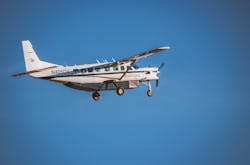Ampaire makes first flight in its hybrid regional aircraft
CAMARILLO, Calif., - Ampaire in Los Angeles announced that its Eco Caravan, a nine-seat regional aircraft, made its first flight 18 November on a fully-integrated hybrid-electric propulsion system. Ampaire expects it to be the first electrified regional aircraft to enter commercial service (certification in 2024) and the first in a series of larger Ampaire hybrid-electric aircraft.
The Eco Caravan upgrades the standard Cessna Grand Caravan with Ampaire's integrated propulsion system of a compression ignition engine and an electric engine. A battery pack in a body fairing preserves passenger and cargo capacity for the aircraft.
The Eco Caravan reduces fuel consumption and emissions by up to 70 percent. Ampaire says that the cost of operation is reduced by 25 to 40 percent depending on airline route structure, and the cost per available seat mile is near that of driving.
The hybrid-electric aircraft preserves the range/payload capability of the Grand Caravan, and in fact can fly farther than the Grand Caravan with eight passengers. Maximum range is beyond 1,000 miles. The Eco Caravan's range and load hauling capability is in marked contrast to proposed all-electric, hydrogen-electric and even other hybrid-electric designs.
The Eco Caravan can recharge its batteries in flight or at a charging stations on the ground. Because charging infrastructure will be limited for some years, the ability to operate independent of ground charging is critical for preserving the full utility of the Eco Caravan.
The Eco Caravan's propulsion technology is scalable to larger regional aircraft and ultimately to single-aisle airliners. Ampaire plans to rapidly roll out more powerful propulsion systems for larger aircraft, following a building blocks approach that will dramatically improve the sustainability of airline operations.
The first flight was 33 minutes in duration to make initial checks of the propulsion system. With test pilot Elliot Seguin at the controls, the Eco Caravan took off from Camarillo Airport north of Los Angeles at 7:49AM PST. It climbed to 3,500 feet at full power, combining power from the combustion engine and electric engine. Seguin then throttled back to a cruise setting, reducing load on both power sources. He spent roughly 20 minutes testing various power settings while studying temperatures and other readings before making a descent and final approach to Camarillo at a low power setting. "The Eco Caravan propulsion system performed just as expected," said Seguin. "It was smooth and quiet. All temperature and power output readings were normal."
Ampaire is already working with the FAA to certify the Eco Caravan in 2024 under a supplemental type certificate (STC). The Ampaire approach differs from others in that it does not require a full aircraft certification program, which can be time consuming and very expensive. The Grand Caravan is already FAA certified. Ampaire will certify it to fly with a new propulsion system.
